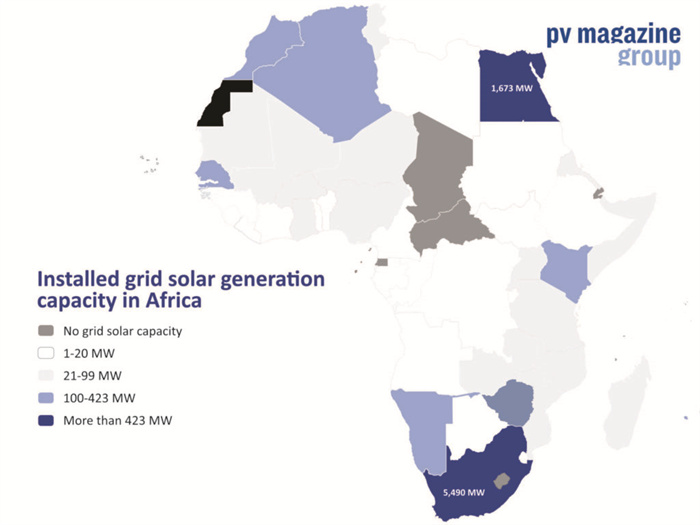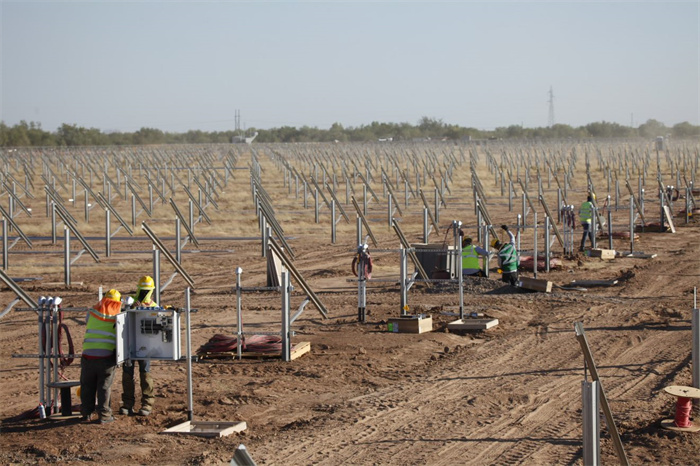The Africa Solar Industry Association has recorded almost 2 GW of large scale project announcements since the start of last month with 18 countries planning new clean power infrastructure and including energy storage in the plants.
COMMERCIAL & INDUSTRIAL PV HIGHLIGHTS MARKETS MARKETS & POLICY POLICY RESIDENTIAL PV UTILITY SCALE PV UTILITY SCALE STORAGE BOTSWANA BURKINA FASO BURUNDI COTE D’IVOIRE DR CONGO LIBYA MADAGASCAR MAURITIUS MOZAMBIQUE NAMIBIA NIGER SAO TOME & PRINCIPE SOMALIA SOUTH AFRICA TANZANIA TOGO ZAMBIA ZIMBABWE

The 540 MW of solar generation capacity and 1.14 GWh of energy storage awarded to Norwegian developer Scatec to help keep the lights on in South Africa recently is the biggest project award of what trade body the Africa Solar Industry Association (AFSIA) has described as “an unprecedented series of large scale” PV facilities on the continent.
The membership organization has recorded 1,879 MW of utility scale solar and storage project announcements in the five weeks since the start of June, it said in a post on its website.
Scatec’s Kenhardt project – awarded in a coal-exempt but otherwise technology-neutral ‘risk-mitigation’ tender held by the South African government to address frequent grid failings – was the largest of the recent awards, which also included seven project announcements for total generation capacity of 70 MW in Zimbabwe among a list of facilities across 18 nations.
Three Togolese projects on the list amount to 225 MW of new solar in development or announced and two facilities in the Democratic Republic of Congo (DRC) will add 200 MW, the same volume as the Serenje PV plant planned by the Zambian operation of U.S. clean power developer Ultra Green Corporation in the DRC’s southern neighbor. Two plants will add a projected 180 MW in Tanzania and two Namibian projects announced in the last five weeks are due to add 111 MW of solar.
The smallest project included on a list of solar and storage plans announced in Cote D’Ivoire (a total of 75 MW); Niger (60 MW); Botswana (50 MW); Madagascar (20 MW and 5 MWh of storage); Mozambique (19 MW plus 7 MWh); Burkina Faso (17 MW); the breakaway Republic of Somaliland in Somalia (8 MW/2 MWh); Mauritius (8 MW); and Burundi (7.5 MW), was a 550 kW array planned in Sao Tome and Principe. The latter project was one of two which will add a total of 2.15 MW of generation capacity in the offshore state. The list also included plans for the Rebiana Solar Plant by Italian energy company ENI in Libya, although no details of scale were given.
AFSIA noted the re-emergence of the World Bank’s Scaling Solar campaign as an important driver in generation capacity, following the initiative’s failure to deliver an anticipated hundreds of megawatts of photovoltaics in Ethiopia. This year, said the trade body on Wednesday, the program has delivered plans for 50 MW of solar in Niger, 60 MW in Cote d’Ivoire and 190 MW in Togo.
The continental industry grouping noted the floodgates may finally be opening for clean power in Botswana after state-owned electric utility the Botswana Power Corporation licenced local developer Shumba Energy to develop 100 MW of solar as the nation’s first independent power producer. AFSIA said the move had followed years of disappointment for solar developers who had expressed interest in annual 100 MW clean power tenders which were never followed up. The Southern African nation also introduced a net metering and feed-in tariff program late last year which will allow for 8 MW of commercial and industrial (C&I) and 2 MW of household solar in its first year.
The Zimbabwe Energy Regulatory Authority is behind that country’s presence in the list, after granting seven licences for more than 66 MW of generation capacity and AFSIA estimates there are also plans for more than 1 GW of private, C&I solar projects in the country, including the 200 MW to be installed by U.K.-based platinum miner Zimplats at its Mimosa operation.

Part of the article excerpted from the network, infringement contact deleted.